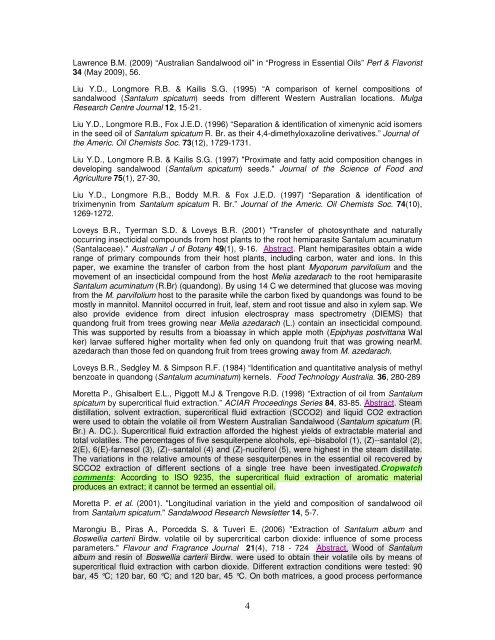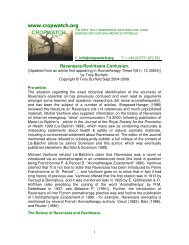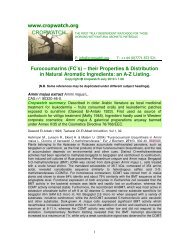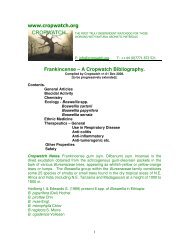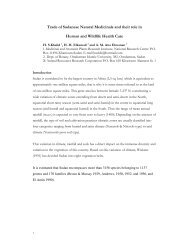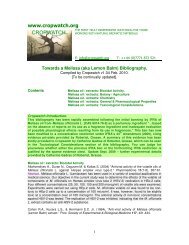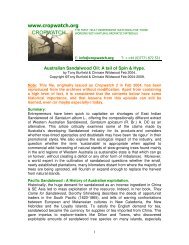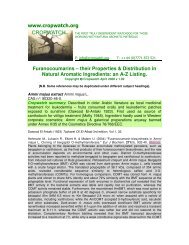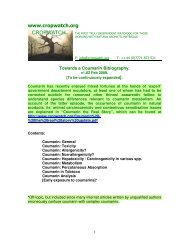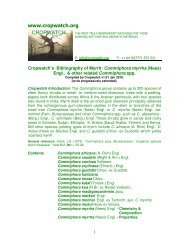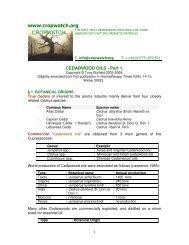Sandalwood Biblio - Cropwatch
Sandalwood Biblio - Cropwatch
Sandalwood Biblio - Cropwatch
Create successful ePaper yourself
Turn your PDF publications into a flip-book with our unique Google optimized e-Paper software.
Lawrence B.M. (2009) “Australian <strong>Sandalwood</strong> oil” in “Progress in Essential Oils” Perf & Flavorist<br />
34 (May 2009), 56.<br />
Liu Y.D., Longmore R.B. & Kailis S.G. (1995) “A comparison of kernel compositions of<br />
sandalwood (Santalum spicatum) seeds from different Western Australian locations. Mulga<br />
Research Centre Journal 12, 15-21.<br />
Liu Y.D., Longmore R.B., Fox J.E.D. (1996) “Separation & identification of ximenynic acid isomers<br />
in the seed oil of Santalum spicatum R. Br. as their 4,4-dimethyloxazoline derivatives.” Journal of<br />
the Americ. Oil Chemists Soc. 73(12), 1729-1731.<br />
Liu Y.D., Longmore R.B. & Kailis S.G. (1997) "Proximate and fatty acid composition changes in<br />
developing sandalwood (Santalum spicatum) seeds." Journal of the Science of Food and<br />
Agriculture 75(1), 27-30,<br />
Liu Y.D., Longmore R.B., Boddy M.R. & Fox J.E.D. (1997) “Separation & identification of<br />
triximenynin from Santalum spicatum R. Br.” Journal of the Americ. Oil Chemists Soc. 74(10),<br />
1269-1272.<br />
Loveys B.R., Tyerman S.D. & Loveys B.R. (2001) "Transfer of photosynthate and naturally<br />
occurring insecticidal compounds from host plants to the root hemiparasite Santalum acuminatum<br />
(Santalaceae)." Australian J of Botany 49(1), 9-16. Abstract. Plant hemiparasites obtain a wide<br />
range of primary compounds from their host plants, including carbon, water and ions. In this<br />
paper, we examine the transfer of carbon from the host plant Myoporum parvifolium and the<br />
movement of an insecticidal compound from the host Melia azedarach to the root hemiparasite<br />
Santalum acuminatum (R.Br) (quandong). By using 14 C we determined that glucose was moving<br />
from the M. parvifolium host to the parasite while the carbon fixed by quandongs was found to be<br />
mostly in mannitol. Mannitol occurred in fruit, leaf, stem and root tissue and also in xylem sap. We<br />
also provide evidence from direct infusion electrospray mass spectrometry (DIEMS) that<br />
quandong fruit from trees growing near Melia azedarach (L.) contain an insecticidal compound.<br />
This was supported by results from a bioassay in which apple moth (Epiphyas postvittana Wal<br />
ker) larvae suffered higher mortality when fed only on quandong fruit that was growing nearM.<br />
azedarach than those fed on quandong fruit from trees growing away from M. azedarach.<br />
Loveys B.R., Sedgley M. & Simpson R.F. (1984) “Identification and quantitative analysis of methyl<br />
benzoate in quandong (Santalum acuminatum) kernels. Food Technology Australia. 36, 280-289<br />
Moretta P., Ghisalbert E.L., Piggott M.J & Trengove R.D. (1998) “Extraction of oil from Santalum<br />
spicatum by supercritical fluid extraction.” ACIAR Proceedings Series 84, 83-85. Abstract. Steam<br />
distillation, solvent extraction, supercritical fluid extraction (SCCO2) and liquid CO2 extraction<br />
were used to obtain the volatile oil from Western Australian <strong>Sandalwood</strong> (Santalum spicatum (R.<br />
Br.) A. DC.). Supercritical fluid extraction afforded the highest yields of extractable material and<br />
total volatiles. The percentages of five sesquiterpene alcohols, epi--bisabolol (1), (Z)--santalol (2),<br />
2(E), 6(E)-farnesol (3), (Z)--santalol (4) and (Z)-nuciferol (5), were highest in the steam distillate.<br />
The variations in the relative amounts of these sesquiterpenes in the essential oil recovered by<br />
SCCO2 extraction of different sections of a single tree have been investigated.<strong>Cropwatch</strong><br />
comments: According to ISO 9235, the supercritical fluid extraction of aromatic material<br />
produces an extract; it cannot be termed an essential oil.<br />
Moretta P. et al. (2001). "Longitudinal variation in the yield and composition of sandalwood oil<br />
from Santalum spicatum." <strong>Sandalwood</strong> Research Newsletter 14, 5-7.<br />
Marongiu B., Piras A., Porcedda S. & Tuveri E. (2006) "Extraction of Santalum album and<br />
Boswellia carterii Birdw. volatile oil by supercritical carbon dioxide: influence of some process<br />
parameters." Flavour and Fragrance Journal 21(4), 718 - 724 Abstract. Wood of Santalum<br />
album and resin of Boswellia carterii Birdw. were used to obtain their volatile oils by means of<br />
supercritical fluid extraction with carbon dioxide. Different extraction conditions were tested: 90<br />
bar, 45 °C; 120 bar, 60 °C; and 120 bar, 45 °C. On both matrices, a good process performance<br />
4


